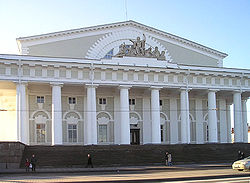- Old Saint Petersburg Stock Exchange
-
Main article: Old Saint Petersburg Stock Exchange and Rostral Columns
Old Saint Petersburg Stock Exchange located in Saint Petersburg, Russia is the main building in the architectural complex of The Spit of Vasilyevsky Island. The building, which is situated at Birzhevaya Ploschad 4, is a significant example of the Greek Revival architecture. Designed by French architect Thomas de Thomon and inspired by the Greek Temple of Hera at Paestum, the stock exchange was constructed between 1805 and 1810. It was built for the St. Petersburg Stock Exchange, but was subsequently used for a different purpose. As of 2011 the building houses the exposition of the Central Naval Museum.
Contents
History
In 1767 the Committee of City Building made a decision to develop a vacant space on the spit of Vasilevsky Island and approved the plan.
The Old Stock Exchange was initially built by edict of Peter the Great for Saint Petersburg Stock Exchange, which he founded inspired by stock exchange in Amsterdam. Later the building. In the six years from 1783 to 1789 on the shores of the Great Neva there were built the main building of the Academy of Sciences and the concave portion of the northern warehouse (1795–1797). Thus was built the building on the left and right of the location of future Stock Exchange building.
Description
The Old Stock Exchange is sited to fill the majestic sweep of the Spit (in Russian Strelka) of Vasilievsky Island, just opposite the Winter Palace. Thomon's design called for a peristyle of forty four Doric columns resting upon a massive stylobate of red granite and supporting an entablature of triglyphs and slotted metopes. A monumental sculptural group similar in form to a quadriga featuring Neptune, and symbolizing maritime commerce, is mounted above the portico. Both inside and outside the Bourse, a motif of the semicircle is recurrent. The interior features a large colonnaded trading hall, now divided into eight exhibition halls. The central rooms are illuminated by an oblong skylight. The surrounding ceiling features double-sunk coffers.
The Central Naval Museum traces its founding to Peter the Great's creation of his "Model Chamber" in 1709 – a collection of models of ships in the Russian Navy. In 1805 the collection was augmented and renamed the Russian Naval Museum. Following the Russian Revolution, and the establishment of a Communist economic system, the building ceased to function as a stock exchange. During this period the collection received many pieces confiscated from private collections. In 1939 the Old Stock Exchange was assigned to house the growing collection renamed the Central Naval Museum.
Today the collection has over 8,000 items including a ship belonging to Peter the Great in which he learned to sail while a teenager. The collection includes several ancient ships, model ships, submarines, engravings, uniforms and photographs documenting the Russian Navy from the time of the Russian Empire, the U.S.S.R., and Russian Federation.
External links
- Бунин М. С. Стрелка Васильевского острова: История формирования архитектурного ансамбля. М.; Л., 1958.
- Канн П. Я. Стрелка Васильевского острова. Л., 1973.
Categories:- Buildings and structures in Saint Petersburg
- Museums in Saint Petersburg
- Greek Revival buildings
- Buildings and structures completed in 1810
- Maritime museums
Wikimedia Foundation. 2010.


